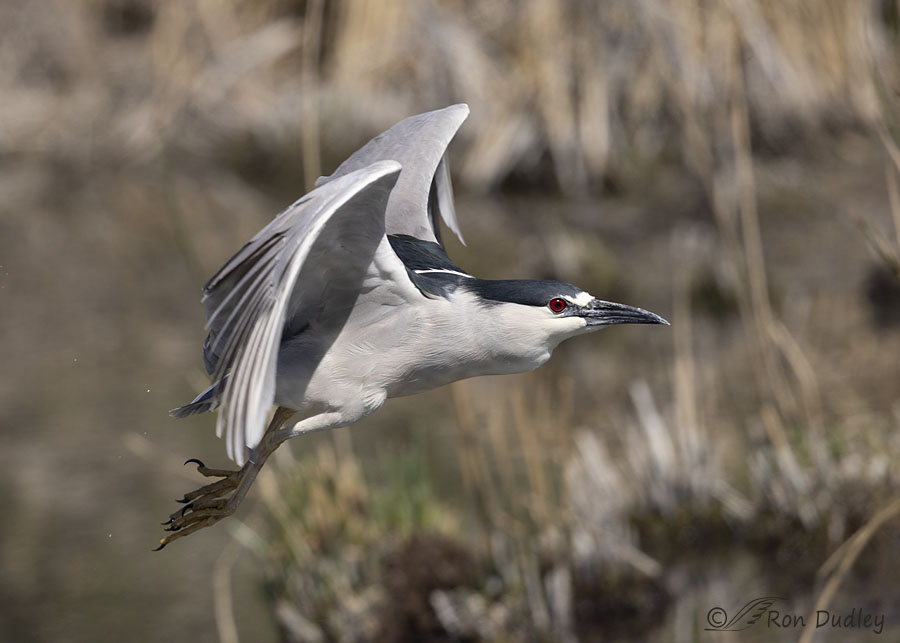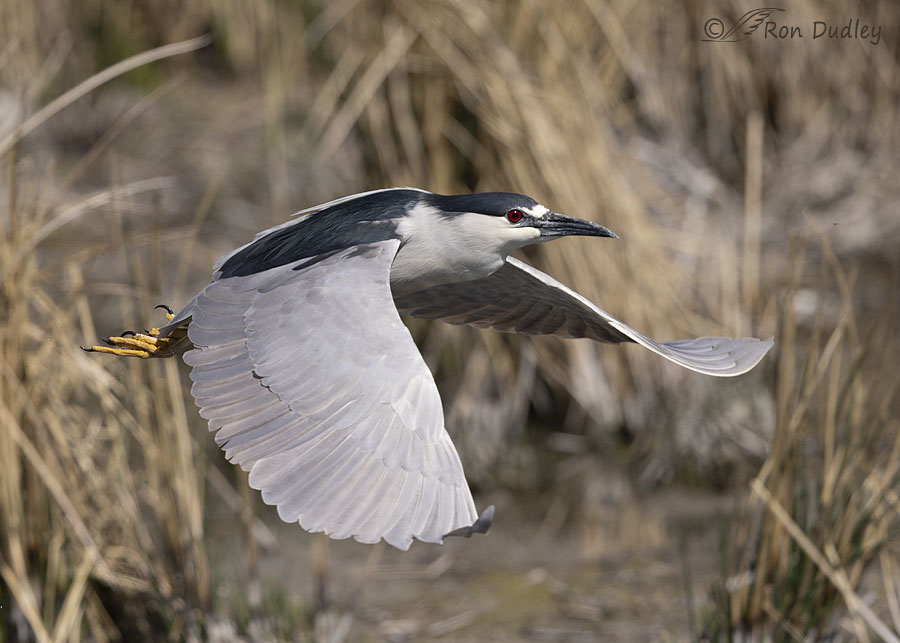Sometimes grab shots actually turn out well.

1/5000, f/6.3, ISO 400, Canon R5, Canon EF500mm f/4L IS II USM + 1.4 tc, not baited, set up or called in
Yesterday morning in Box Elder County I took many photos I like of this Black-crowned Night Heron while he was perched on a tiny island of stubby reeds in the middle of a pond. Eventually ‘he’ became comfortable with my presence and started hunting for prey. I thought he was fishing but his prey turned out to be aquatic insects. I kept waiting for him to take off so I could get flight shots but it didn’t happen so after spending 21 minutes with him and taking 389 photos I gave up and began stowing my gear to leave the area.
I’m sure you saw this coming – that’s when he decided to take off. I quickly raised my lens, poked it out the window, and got 11 shots of him in flight before he passed in front of my pickup and landed on the other side of the road. He was really too close for flight shots so I cut off a lot of body parts but I managed to get several photos I like with no clipping or amputations. These are two of them.

1/5000, f/6.3, ISO 400, Canon R5, Canon EF500mm f/4L IS II USM + 1.4 tc, not baited, set up or called in
I think I like this one best, even though it’s just a tiny bit less sharp than the previous photo. Normally I’d allow more room in the frame for the bird but I was so close I didn’t have that room for this series.
Yesterday I learned (once again) that I can have a lot of fun in the field with birds that don’t cooperate. Frustration doesn’t always mean aggravation, especially when some of the species and behaviors involved are unusual for me. Just seeing them, and trying for decent photos, can be entertaining, rewarding, educational and skill-building and the mediocre photos I get can at least document what I’ve seen.
Sometimes that’s enough for me. I hope it is for my readers too because you’ll likely be seeing some of those photos soon.
Ron


Superb flight shots Ron! Thanks for shRIG!
Charlotte Norton
Oh that second shot…
I would be over the moon (and possibly out of the stratosphere) to get either of these ‘grab shots’.
I’m pretty happy with them too, EC. Especially the second one. Thanks.
Have always loved these little herons (in comparison to the much-larger Great Blues) … have seen them many times “skulking through the reeds” as Judy notes, or standing on a little dam on the Platte River in Denver enjoying the water rushing over their feet … but in flight is rare, indeed. You’ve captured their unexpected beauty so well with these images!
Thank you, Chris.
I think they are both great photos. One thing about my broken camera gear, it makes me less expectant of my shots. I have relaxed about what I might get. I can just watch the birds through my lens with a few grabbed shots. It is a crap shoot, sometimes I get sharp correctly exposed and other times it is all off. Seems like days the camera is good it stays good most of the session. When is it not functioning it is mostly all bad. I have found how much I relied on my preview ability with the LCD screen on the back, so I can check for exposure, sharpness etc. without it working I believe I have become a much better photographer shooting in manual modes and getting the settings correct for the conditions through my own experience and knowledge. It does frustrate me when the camera sensor goes awry and suddenly starts shooting at 1/2000 to 1/8000 of a second on it’s own. The majority of those shots are dark and not salvageable. Oh well, the new camera body arrives today so I get to start a new set of frustrations with learning the new system. I think I will head over to Sugarhouse Park or Liberty and try for birds at the ponds to experiment before taking it to a reserve.
“I think I will head over to Sugarhouse Park or Liberty”
That’s exactly what I did when I bought the R5 – I headed to our local pond and spent a lot of time down there practicing with it. I also have a small ceramic dog with prominent eyes in my living room that gives me great practice with animal/eye recognition and other camera features. When I have my camera on my tripod in my bedroom I can see all the way through my house to “Tommy”, my ceramic dog in the living room.
Have fun with your new (expensive) toy, April.
“Sometimes that’s enough for me.” Indeed.
That second one is elegant.
Thank you, Michael.
I agree 100% with your last paragraph. And the images are real nice too!
Bruce, admittedly it took me longer than it should have to learn to appreciate some of those things in my last paragraph.
How beautiful…softly soaring skyward.
Thanks, Mary.
Wonderful photos, especially so for grab shots. It appears your muscle memory for operating the R5 is becoming well-developed.
The sweep and arc of the wings in both photos is beautiful. The combination of the yellow legs and black claws is always a very stylish look.
“It appears your muscle memory for operating the R5 is becoming well-developed.”
It depends on the situation, Lyle. For shots like these, yes. But when I’m trying to photograph small birds in thick vegetation it’s another story – I still struggle with the controls of the R5.
Oh– THOSE WINGS in shot #2– you’ve captured such a broad, graceful
sweep– even the extended feet contribute to the effect of an air “dancer”–
just lovely…….
Kris, when I get photos of this species in flight I’m often impressed by how wide their wings are. Those wings can scoop a lot of air!
These two are beautiful. I am dripping with envy. If I was younger I would buy the R5 and learn how to use it, but there are not enough years left for me to catch up with you. Outstanding – and one of my favorite birds.
That sure is Murphy’s Law though – you start to pack up your gear and the bird finally does what you waited a half hour for.
Everett, at this point you wouldn’t have a lot to catch up to (I’m still learning the R5) and besides, you don’t have to catch up. I think you’d have a lot of fun with the R5, to go along with the aggravation….
Beautiful! Best planned shot would be hard put to match these! 1st one I’ve seen in flight – MUCH more beautiful than when skulking through the reeds etc.
Judy, I agree – the habitat they’re often found in (old phrags for example) isn’t much for aesthetics.